Borrelia burgdorferi RNA induces type I and III interferons via Toll-like receptor 7 and contributes to production of NF-κB-dependent cytokines
- PMID: 24664510
- PMCID: PMC4019181
- DOI: 10.1128/IAI.01617-14
Borrelia burgdorferi RNA induces type I and III interferons via Toll-like receptor 7 and contributes to production of NF-κB-dependent cytokines
Abstract
Borrelia burgdorferi elicits a potent cytokine response through activation of multiple signaling receptors on innate immune cells. Spirochetal lipoproteins initiate expression of NF-κB-dependent cytokines primarily via TLR2, whereas type I interferon (IFN) production is induced through the endosomal receptors TLR7 and TLR9 in human dendritic cells and TLR8 in monocytes. We demonstrate that DNA and RNA are the B. burgdorferi components that initiate a type I IFN response by human peripheral blood mononuclear cells (PBMCs). IFN-α protein and transcripts for IRF7, MX1, and OAS1 were induced by endosomal delivery of B. burgdorferi DNA, RNA, or whole-cell lysate, but not by lysate that had been treated with DNase and RNase. Induction of IFN-α and IFN-λ1, a type III IFN, by B. burgdorferi RNA or live spirochetes required TLR7-dependent signaling and correlated with significantly enhanced transcription and expression of IRF7 but not IRF3. Induction of type I and type III IFNs by B. burgdorferi RNA could be completely abrogated by a TLR7 inhibitor, IRS661. In addition to type I and type III IFNs, B. burgdorferi RNA contributed to the production of the NF-κB-dependent cytokines, IFN-γ, interleukin-10 (IL-10), IL-1β, IL-6, and tumor necrosis factor alpha (TNF-α), by human PBMCs. Collectively, these data indicate that TLR7-dependent recognition of RNA is pivotal for IFN-α and IFN-λ1 production by human PBMCs, and that RNA-initiated signaling contributes to full potentiation of the cytokine response generated during B. burgdorferi infection.
Figures
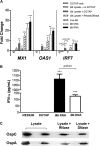

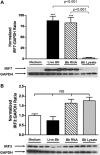
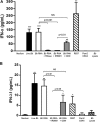
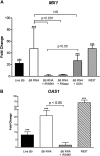
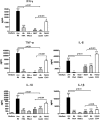

Similar articles
-
Recognition of Borrelia burgdorferi, the Lyme disease spirochete, by TLR7 and TLR9 induces a type I IFN response by human immune cells.J Immunol. 2009 Oct 15;183(8):5279-92. doi: 10.4049/jimmunol.0901390. Epub 2009 Sep 30. J Immunol. 2009. PMID: 19794067
-
Human TLR8 is activated upon recognition of Borrelia burgdorferi RNA in the phagosome of human monocytes.J Leukoc Biol. 2013 Dec;94(6):1231-41. doi: 10.1189/jlb.0413206. Epub 2013 Aug 1. J Leukoc Biol. 2013. PMID: 23906644 Free PMC article. Clinical Trial.
-
Induction of indoleamine 2,3-dioxygenase by Borrelia burgdorferi in human immune cells correlates with pathogenic potential.J Leukoc Biol. 2015 Feb;97(2):379-90. doi: 10.1189/jlb.4A0714-339R. Epub 2014 Nov 24. J Leukoc Biol. 2015. PMID: 25420916 Free PMC article. Clinical Trial.
-
Innate immunity networks during infection with Borrelia burgdorferi.Crit Rev Microbiol. 2016;42(2):233-44. doi: 10.3109/1040841X.2014.929563. Epub 2014 Jun 25. Crit Rev Microbiol. 2016. PMID: 24963691 Review.
-
Mechanisms of Borrelia burgdorferi internalization and intracellular innate immune signaling.Front Cell Infect Microbiol. 2014 Dec 15;4:175. doi: 10.3389/fcimb.2014.00175. eCollection 2014. Front Cell Infect Microbiol. 2014. PMID: 25566512 Free PMC article. Review.
Cited by
-
Toll-like receptor cascade and gene polymorphism in host-pathogen interaction in Lyme disease.J Inflamm Res. 2016 May 31;9:91-102. doi: 10.2147/JIR.S104790. eCollection 2016. J Inflamm Res. 2016. PMID: 27330321 Free PMC article. Review.
-
Comparison of spleen transcriptomes of two wild rodent species reveals differences in the immune response against Borrelia afzelii.Ecol Evol. 2020 May 25;10(13):6421-6434. doi: 10.1002/ece3.6377. eCollection 2020 Jul. Ecol Evol. 2020. PMID: 32724523 Free PMC article.
-
Comparative study of pathogenic and non-pathogenic Escherichia coli outer membrane vesicles and prediction of host-interactions with TLR signaling pathways.BMC Res Notes. 2018 Aug 1;11(1):539. doi: 10.1186/s13104-018-3648-3. BMC Res Notes. 2018. PMID: 30068381 Free PMC article.
-
Borrelia burgdorferi induces a type I interferon response during early stages of disseminated infection in mice.BMC Microbiol. 2016 Mar 8;16:29. doi: 10.1186/s12866-016-0644-4. BMC Microbiol. 2016. PMID: 26957120 Free PMC article.
-
RNA of Enterococcus faecalis Strain EC-12 Is a Major Component Inducing Interleukin-12 Production from Human Monocytic Cells.PLoS One. 2015 Jun 17;10(6):e0129806. doi: 10.1371/journal.pone.0129806. eCollection 2015. PLoS One. 2015. PMID: 26083838 Free PMC article.
References
-
- Radolf JD, Arndt LL, Akins DR, Curetty LL, Levi ME, Shen Y, Davis LS, Norgard MV. 1995. Treponema pallidum and Borrelia burgdorferi lipoproteins and synthetic lipopeptides activate monocytes/macrophages. J. Immunol. 154:2866–2877 - PubMed
Publication types
MeSH terms
Substances
Grants and funding
LinkOut - more resources
Full Text Sources
Other Literature Sources
Medical
Miscellaneous

